Throughout this series we have looked at the historical background of the West’s support for and use of Islamist forces as proxy armies and ‘shock troops.’ We have also considered how they were instrumental in the creation of al Qaeda and how the UK became a center for radicalisation and recruitment in Europe. However, few stories illustrate the West’s absolute complicity in the creation of the Islamist extremist threat better than that of Ali Mohamed.
Ali Mohamed was a highly educated, multilingual, Egyptian Army Major who was attached to a Special Forces training program at Fort Bragg in North Carolina in 1981. Members of his Egyptian army unit were involved in the assassination of President Anwar Sadat. Concerns we raised, by his commanding officers, that Mohamed was ‘too religious.’ He was forced to resign in 1984 and immediately offered his services to the CIA who welcome him into the fold. He then made contact with the German branch of Hezbollah and, according to the CIA, revealed his role with the Americans to the Iranian backed militants. He reportedly offered himself to Hezbollah as their mole inside U.S. intelligence.
In response, the CIA claimed to have severed their relationship with him and placed Ali Mohamed on a terrorist watch list to prevent his return to the U.S. It isn’t really clear how else they thought a former U.S. special forces soldier would sell himself to an international terrorist organisation. In any event, while on the terrorist watch list, Mohamed gained an American visa and flew back into the U.S. in 1985. At the 1995 trial of Sheik Omar Abdul-Rahman, it was revealed that Mohamed had received his visa as part of a clandestine CIA program.
The CIA story, that Mohamed had been kicked out, appears to have been nothing more than a subterfuge to ingratiate him with the German Hezbollah and other terrorist organisations. In 1985 he married in the U.S. and subsequently gained his U.S. citizenship in 1989. He joined the U.S. army and became an instructor at the John F. Kennedy Special Warfare School at Fort Bragg in 1986. The unit specialised in preparing soldiers and operatives for operations in the Middle East and elsewhere. He was honourably discharged from the military in 1989 with commendations on his file for ‘patriotism, valor, fidelity, and professional excellence.‘ Mohamed remained a U.S. military reservist until 1994.
However, the simplistic story of the counter-terrorism expert who assisted his adopted nation’s fight against the blight of Islamist extremism or even the oft stated counter narrative of the Islamist extremists who infiltrated the military and intelligence services, is very far from the whole story . Ali’s activities, throughout the 80s and 90s, appear to place him at the heart of an intricate web of double-cross and deceit which paints a far more complex picture.
By 1987 Ali had formed a working relationship with Egyptian medical student Khaled Abu el Dahab. He convinced el Dahab to emigrate to the States, where he took up residence close to Ali Mohamed’s Californian home. At the same time Mohamed started training recruits at the MAK funded Al-Kifah Refugee Center in Brooklyn, before they were despatched to fight under Osama bin Laden and Ayman al Zawahiri in Afghanistan as part of Operation Cyclone. Meanwhile, back in Santa Clara, Khaled Abu el Dahab, with the support of Mohamed, was busy putting his computing and communications skills to use.
He established a central telecommunications hub to coordinate and facilitate a growing global Islamist network. He created a secure three-way connection system, enabling operatives to communicate internationally, and is known to have received calls from Ayman al Zawahiri, among other notable extremists; he recruited a number of U.S. based extremists and, during a visit to Afghanistan with Ali Mohammad, was personally congratulated by Osama bin Laden (who wanted U.S. passport holders to be al Qaeda fighters); he was trained in the use of weapons and explosives by Mohamed and others and provided a safe house for U.S. based Islamists; while in the U.S. he learned to fly helicopters and gliders and worked with Mohammad to translate U.S. military training manuals, and other documents, into Arabic before distributing them internationally. The ‘Manchester Manual‘ was an example of his and Mohamed’s work.
In 1989 Hassan al-Turabi became the President of Sudan. A fervent Islamist, he sent word to Osama bin Laden that he was welcome to set up operations in Sudan. Initially bin Laden was hesitant, wanting to maintain a fuller presence in Afghanistan and Pakistan and particularly to maintain his Afghan training camps. In 1991 Ali Mohammad was instrumental in encouraging bin Laden’s relocation to Sudan, following the end of Operation Cyclone.
Having already proved his value as a trainer for bin Laden’s forces during the Afghan – Soviet war, once in Sudan, Mohamed became the chief instructor for bin Laden’s large scale al Qaeda training operation on the outskirts of Khartoum. He trained more than 2000 Islamists in techniques ranging from kidnapping, bomb-making, covert operations, urban warfare, and more.
During the late 80s and early 90s Ali Mohammad became al Qaeda’s most important trainer. He played a significant role in turning young inexperienced, international recruits, including some from Western nations, into hardened, capable fighters. They began to form a formidable, highly mobile, military force under his tutelage. With international coordination, facilitated in part by Khaled Abu el Dahab telecommunications hub in California, which Mohammad had also set up, his value to the growing terrorist network was considerable. He was at the centre of the organisation who would soon draw the U.S. military industrial intelligence complex into the longest foreign war in its history (Afghanistan) and ignite a global ‘war on terror.’
Nor were his activities limited just to the U.S., Central Asia, Middle East and sub-Saharan Africa. In 1992 he led a covert operations team who trained Mujahideen and al Qaeda combat troops in Bosnia. The 14 man team, consisting of ‘retired’ U.S. military personnel, entered Bosnia through Croatia and set up a training camp in Meskovic, a village near the town of Tuzla. CIA support for the Bosnian Islamist came through the ‘Croatian pipeline.’ Arms bought in Iran and Turkey, with Saudi ‘front’ money, were dropped by blacked out Hercules C-130s to the waiting forces below. A Dutch governmental report into the breach of the U.N embargo stated that Islamist fighters also entered the conflict through this route.
The early 90s were an extremely busy time for Ali Mohamed, as he travelled to and from the U.S., using a variety of pseudonyms like ‘Abu Abdullah’, depending upon his required persona. By 1993 he was active in multiple theatres and some of his students at the Al-Kifah Refugee Center had progressed to the World Trade Center bombing.
Leaving Ali Mohamed aside, the WTC bomb plotters were heavily infiltrated and the key witness, Emad Salem, who identified the alleged ringleader, Ramzi Yousef, was an intelligence agent who testified that the FBI were aware of the plot. They had intended to swap the explosive for an inert substitute but the plan went awry and the bomb partially detonated. Many of those involved in the bombing were trained by the CIA to fight in Afghanistan and the CIA later admitted that it was ‘partly culpable‘ for killing six people in the blast.
By 1994 some within al Qaeda, perhaps wary of the former U.S. Green Beret’s influence, started to have suspicions about Ali Mohamed. Mohammed Atef, a senior al Qaeda commander, refused to disclose travel details to Abu Mohamed al Amriki (‘The American’ – Ali Mohamed.) In 2001, al Qaeda operative L’Houssaine Kherchtou testified that Atef suspected him of “working for the Americans.”
Throughout 1994 and 1995 Ali Mohamed trained a new intake of bodyguards for Osama bin Laden, after a series of failed assassination attempts upon him. Although not exactly clear, around the end of 1994, he helped Ayman al Zawahiri get into the U.S. (not for the first time.) Zawahiri travelled on forged documents supplied by Mohamed and also met with Khaled Abu el Dahab in Santa Clara. Possibly during his trip, in December 1994, the FBI received a tip from ‘someone’ about the whereabouts of Mohammed Jamal Khalifa, bin Laden’s brother-in-law, living just 30 miles from Santa Clara. They arrested him and found a number of valuable intelligence documents but then, for some reason, let him go.
According to the 1999 testimony of Khaled Abu el Dahab, it was around 1996 that Ali Mohamed started to fall out of favour with the al Qaeda leadership. Their military commander Atef was already suspicious and others started to question where al Amriki’s loyalties lay. Caving under pressure from the U.S. State Department, the Sudanese government expelled Osama bin Laden. He left in a Hercules C-130 transport and al Qaeda shipped their personnel, equipment and resources back to Afghanistan.
They also withdrew much of their Somali based operations. In 1998, while the world’s intelligence agencies frantically searched for the terrorist Osama bin Laden, ABC’s John Miller conducted a TV interview with him. During the interview bin Laden told Miller that he had sent a team to train the Somalian military forces commanded by Mohamed Farrah Hassan Aidid. One of those he dispatched on the training missions, between 1992 and 1994, was Ali Mohamed.
Mohamed’s handling of security for the 1996 moves from Sudan and Somalia appears to be one of the last services he provided for al Qaeda. Despite being fully aware of bin Laden’s movements the U.S, who had forces stationed in the region, did nothing to stop or apprehend him. Much to the mystification of Sudan’s defence minister Elfatih Erwa who later said:
“We warned [the US]. In Sudan, bin Laden and his money were under our control. But we knew that if he went to Afghanistan no one could control him. The US didn’t care; they just didn’t want him in Somalia. It’s crazy.”
The official explanation, in as far as there is one, for Ali Mohamed’s activities is of the al Qaeda ‘double agent’ who infiltrated the Western military and state intelligence services. While it is acknowledged that Western backing for the Mujahideen was a complicated affair, the claim was that he essentially betrayed the West. He was arrested in 1998 shortly after the U.S. embassy bombings in which he played a major organisational role. At his trial in 2000, his lengthy confession appeared to support the allegation that he was first and foremost an al Qaeda operative. However, if we look at his relationship with U.S. intelligence and security service, throughout his active years with al Qaeda, another distinct possibility is evident.
Ali Mohamed’s instructor role at the Al-Kifah Refugee Center in Brooklyn started while he was working at the John F. Kennedy Special Warfare School in Carolina. Theses trips to New York happened after his known relationship with the CIA began, and are said to have taken place during his ‘weekends off.’ Which is why no one knew what he was doing, allegedly. In 1986 he was sent to Afghanistan to train the Mujahideen. His attitude and claimed desire to “kill Russians” prompted his Fort Bragg commander Lt. Col. Robert Anderson to raise concerns with military intelligence about his activities, but he reportedly didn’t receive a response. Then, in 1988 he took a months leave and went to Afghanistan of his own accord. Freelance combat is strictly forbidden in the U.S. military, so when Ali boasted of his exploits upon his return Col. Anderson wrote another alert and again received no reply.
No action was taken to either stop him going or question him upon his return. He simply resumed his job as a special forces instructor. Should he have been killed or captured while fighting with Islamist forces in Afghanistan, it would have caused a major diplomatic crisis for the U.S, yet nothing was said. During this period Ali was also helping himself to a variety of classified documents, seemingly able to remove them with ease. A highly quizzical Col. Anderson later said:
“I think you or I would have a better chance of winning [the lottery], than an Egyptian major in the unit that assassinated [Egyptian President Anwar] Sadat would have getting a visa, getting to California… getting into the Army and getting assigned to a Special Forces unit. That just doesn’t happen.”
Ali was openly sharing large volumes of these documents and manuals with recruits at the Al-Kifah Refugee Center (during his weekend excursions.) He organised gun training at various ranges in the area for many, including the future WTC bombers. Despite being monitored by the FBI nothing was done to intervene. Later defence lawyer Roger Stavis stated:
“He came quite often and became a real presence in that [Al-Kifah] office, which later metastasized into al Qaeda.… He would bring with him a satchel full of military manuals and documents. It was Ali Mohamed who taught the men how to engage in guerrilla war. He would give courses in how to make bombs, how to use guns, how to make Molotov cocktails.”
In 1990 Ali Mohammad became an informant for the FBI. He maintained this relationship throughout his time as one of al Qaeda’s leading figures. In the same year Egyptian-American El Sayyid Nosair assassinated controversial right-wing Zionist leader Rabbi Meir Kahane. There was a massive amount of evidence linking Nosair to an orchestrated plot, but state prosecutors immediately insisted that he was a ‘lone wolf.’ During a raid on his home many of the documents Ali Mohammad had taken from Fort Bragg (and elsewhere) were found, including instructional videos of talks given by Mohamed at Fort Bragg. Investigators discover that Ali Mohamed had trained Nosair at the gun ranges monitored by the FBI. They also found two of the future WTC bomb plotters at his home, Mahmud Abouhalima and Mohammad Salameh.[100] On top of that, Nosair was also known to frequent the Al-Kifah Center. Yet despite all this Chief Detective for the New York Police Department Joseph Borelli stated:
“[Nosair was a]…..lone deranged gunman.… He didn’t seem to be part of a conspiracy or any terrorist organization.”
It now seems obvious the investigators were told to protect a number of intelligence assets and limit the scope of the investigation solely to Nosair. Later, an FBI field agent claimed:
“The fact is that in 1990, myself and my detectives, we had in our office in handcuffs, the people who blew up the World Trade Center in ‘93. We were told to release them.”
The 1993 investigation into the WTC bombing revisited the evidence surrounding the Nosair case, again exposing Ali Mohamed and his theft of official secrets. Yet nothing was done, and he remained a U.S. Army ‘reservist.’ Shortly afterwards Ali was interviewed by U.S. military intelligence at NSA headquarters at Forte Meade but all records of the conversation were ‘lost.’ Later, in June 1993, Ali was detained in Vancouver by the Royal Canadian Mounted Police (RCMP). They discovered that he was a top al Qaeda operative who had brought bail money from Osama bin Laden for the release of Essam Marzouk, who was being held by the Canadians.
Marzouk was a member of the al Qaeda affiliated group, Ayman al Zawahiri’s ‘Islamic Jihad,’ and had been arrested after being found in possession of numerous false identification documents. Ali Mohamed told the RCMP to contact his FBI handler John Zent. Zent confirmed he worked for the FBI and Mohamed was released. Marzouk remained in detention for a year but was allowed to stay in Canada following his release, and went on to train the 1998 U.S. Embassy bombers.
In 1994, according to the defence lawyer for Nosair, Roger Stavis, Ali allegedly returned to the U.S. on the orders of the FBI. Stavis was formulating a defence for his client that was based on the fact that Nosair was trained by someone who appeared to be an agent for both the CIA and the FBI (Mohamed), therefore his argument was that the U.S. government were just as culpable as his client, Nosair.
Stavis was aware that Mohamed returned to be interviewed by FBI agent Harlan Bell and Assistant US Attorney Andrew McCarthy, one of the prosecutors for the upcoming Nosair trial. However, when the trial came, despite being subpoenaed, Stavis was informed that Ali’s location was unknown. Later Ibrahim El-Gabrowny, Nosair’s cousin, alleged that Mohamed supposedly told him that he got the subpoena but McCarthy advised him to ignore it and that he would ‘cover for him.’
In 1995 Ali Mohamed was declined U.S. security clearance but still managed to get a job for Burns Security as a security guard protecting a Northrop-Grumman factory in California which made triggers for Trident missiles. In the same year the U.S. government filed a confidential court held list of the 1993 WTC bombing suspects. Ali was named on the list but simply continued to live unmolested in California, keeping his day job guarding a ballistic missile components factory. Remarkably, despite this being a highly sensitive document, when police searched his residence after his eventual arrest in 1998, they found he not only had a copy but had shared it with senior al Qaeda figures.
In late 1995 media reports started to emerge which exposed Ali Mohamed. This seems to have coincided with increased ‘interest’ in his activities from the FBI. Although seeing as he had been working for them for at least 4 years they presumably already had some idea who he was and what he was doing. As we have discussed, this also coincided with al Qaeda apparently starting to distance themselves from him. It seems likely at this stage that his value as a possible agent, capable of infiltrating and manipulating global terrorist networks, had waned to a degree.
It appears that in October 1997, U.S. Prosecutor Patrick Fitzgerald and FBI agent Jack Cloonan, who were attached to the I-49 squad tasked with investigating Osama bin Laden, took Ali out for dinner. What apparently followed was a truly amazing conversation. Cloonan later spelt out the purpose of the meeting:
“We wanted to gain his cooperation. We knew of his long history having been connected to al Qaeda, and what we desperately wanted was to convince Ali Mohamed to cooperate with us that night.”
Ali Mohamed then proceeded to tell the two men pretty much everything we’ve outlined here. Cloonan later recalled:
“He said that he was in touch with hundreds of people he could call on in a moment’s notice that could be, quote, ‘operational,’ and wage jihad against the United States. Very brazenly, he said, ‘I can get out anytime and you’ll never find me. I’ve got a whole network. You’ll never find me.”
Following the end of the meal, Cloonan claimed that Fitzgerald turned to him and said:
“This is the most dangerous man I have ever met. We cannot let this man out on the street.”
Yet that is precisely what happened. He still wasn’t arrested and lived freely for another year. At the 9/11 Commission Fitzgerald, speaking about Ali Mohamed’s frequent trips to Afghanistan, said:
“Mohamed did not [make a loyalty pledge] to al Qaeda but he trained most of al Qaeda’s top leadership—including bin Laden and [Ayman] al-Zawahiri—and most of al Qaeda’s top trainers. Mohamed taught surveillance, counter-surveillance, assassinations, kidnapping, codes, ciphers and other intelligence techniques.”
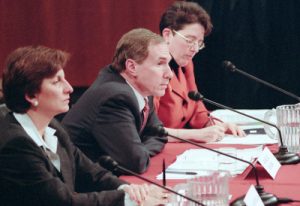
Ali was undoubtedly al Qaeda’s head trainer and the man largely responsible for transforming them from an affiliate group of the Mujahideen into a vicious terrorist organisation, responsible for the deaths of hundreds of thousands. Consequently, seeing as he was in custody and cooperating with U.S. authorities, you would think he would have figured significantly in the 9/11 Commission’s ‘thorough’ investigation into the world changing terrorist attack. Surely the close associate of Osama bin Laden, Ayman al Zawahiri and pretty much every other senior al Qaeda figure, would have been their star witness?
Surprisingly not. Though referenced sparingly and briefly mentioned on a couple of occasions, they didn’t apparently need to speak to him. Which seems a shame seeing as he could presumably have given them a genuine understanding of how al Qaeda actually operated instead of the floundering, ad-hoc inaccuracies they regurgitated. His inexplicable absence from their investigation had absolutely nothing at all to do with Michael Hurley, the man tasked with investigating the evidence he could have offered. Michael Hurley was a former CIA officer who had been a director of operations in Afghanistan, Kosovo and Bosnia, where Ali Mohamed ran terrorist training camps with a team of ‘retired’ U.S. special forces ‘mercenaries.’
Who Ali Mohamed ultimately worked for remains a matter of conjecture. Some of his statements seem to indicate that he was a genuine supporter of the Islamist cause. Conversely, he was also very useful to Western intelligence agencies and the security services. He certainly appears to have been someone they were unable or unwilling to stop.
As Mario Puzo’s ‘Michael Corleone’ said, “If anything in this life is certain, if history has taught us anything, it is that you can kill anyone.” How did Mohammad survive? His role with Western intelligence was exposed in 1995, yet he continued to operate inside al Qaeda for at least another year. He then betrayed the al Qaeda leadership in open court, formally revealing his links to the security services; he was involved in passing state secrets to known terrorists; was directly involved in the killing of Western military personnel and civilians and his activities exposed apparent collusion between the intelligence agencies and listed terrorist organisations, and still he made it to court. How? Was it just luck or was he simply too hard to kill?
The popular image of the super spy, able to outwit everyone, stay one step ahead of the game and fend off any foe, only exists in fiction. Wearing a tuxedo doesn’t protect you from car bombs, laser guided missiles or radioactive poisoning. He wasn’t exactly cautious. His ego clearly got the better of him at times, and he rarely seemed to miss an opportunity to brag about his nefarious exploits. The evidence suggests he felt untouchable. It seems inconceivable that he was able to survive for as long as he did without protection from powerful sponsors.
The terms of Mohamed’s deal with U.S. prosecutors is a state secret. Though perhaps his defence attorney David Ruhnke statement given before his trial, while also designed to protect his client, suggests a possibility:
“I think the most likely thing that will happen is he’ll be released and he’ll be given a new name, a new identity, and he’ll pick up a life some place.”
Speaking in 2006, six years after his trial, his wife Linda Sanchez stated:
“He’s still not sentenced yet, and without him being sentenced I really can’t say much. He can’t talk to anybody. Nobody can get to him…. [the US government has]….got Ali pretty secretive.… It’s like he just kind of vanished [into] thin air”
In 2011 former FBI agent Ali Soufan said that Mohamed was still awaiting sentencing. Mohamed supposedly received a lengthy 25-year sentence at his 2000 trial, having given extensive evidence. However, to date, that sentence doesn’t appear to have been carried out. His current whereabouts are unknown.

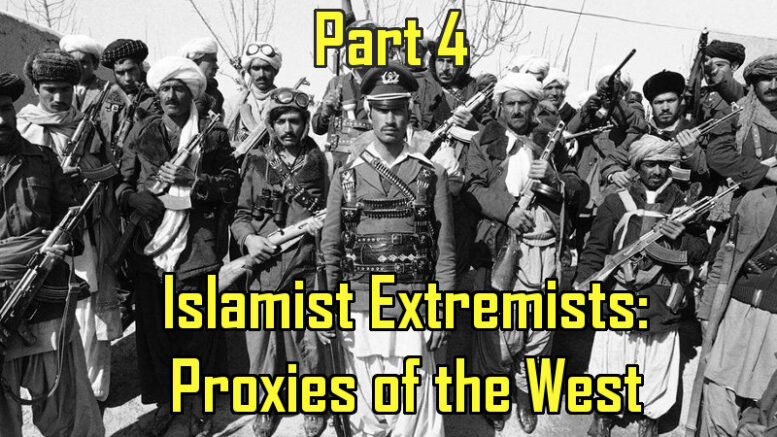

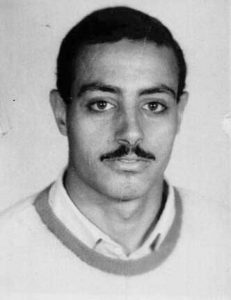
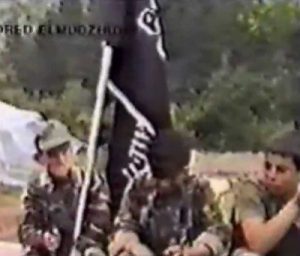
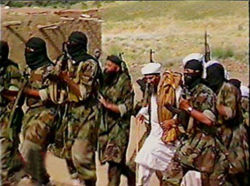
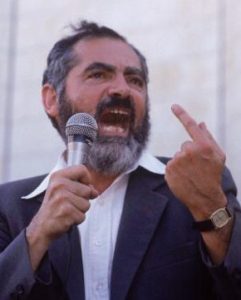
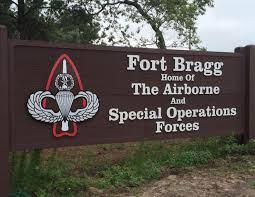


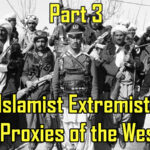



Be the first to comment on "Islamist Extremists – Proxies of the West – Part 4"